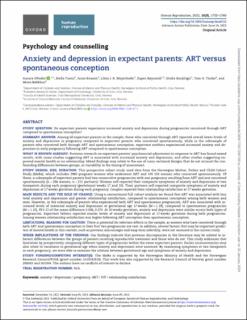| dc.description.abstract | STUDY QUESTION: Do expectant parents experience increased anxiety and depression during pregnancies conceived through ART
compared to spontaneous conception?
SUMMARY ANSWER: Among all expectant parents in the sample, those who conceived through ART reported overall lower levels of anxiety and depression in pregnancy compared to expectant parents who conceived spontaneously, while in the subsample of parents who conceived both through ART and spontaneous conception, expectant mothers experienced increased anxiety and de- pression in early pregnancy following ART compared to spontaneous conception.
WHAT IS KNOWN ALREADY: Previous research on expectant parents’ psychosocial adjustment in response to ART has found mixed results, with some studies suggesting ART is associated with increased anxiety and depression, and other studies suggesting im- proved mental health or no relationship. Mixed findings may relate to the use of cross-sectional designs that do not account for con- founding differences between groups, or variability in the timing of assessment.
STUDY DESIGN, SIZE, DURATION: This prospective cohort study used data from the Norwegian Mother, Father and Child Cohort Study (MoBa), which includes 2960 pregnant women who underwent ART and 108 183 women who conceived spontaneously. Of these, a subsample of expectant parents had two consecutive pregnancies with one pregnancy resulting from ART and one conceived spontaneously (n 1⁄4 286 women, n 1⁄4 211 partners). Women self-reported their composite symptoms of anxiety and depression at two timepoints during each pregnancy (gestational weeks 17 and 30). Their partners self-reported composite symptoms of anxiety and depression at 17 weeks gestation during each pregnancy. Couples reported their relationship satisfaction at 17 weeks gestation.
MAIN RESULTS AND THE ROLE OF CHANGE: Using a conventional full-cohort analysis we found that ART was associated with less total anxiety and depression and greater relationship satisfaction, compared to spontaneous conception among both women and men. However, in the subsample of parents who experienced both ART and spontaneous pregnancies, ART was associated with in- creased levels of maternal anxiety and depression at gestational age 17weeks (M1⁄41.19), compared to spontaneous pregnancies (M 1⁄4 1.15), 95% CI of the mean difference 0.006, 0.074. At 30 weeks gestation, anxiety and depression were similar across both types of pregnancies. Expectant fathers reported similar levels of anxiety and depression at 17weeks gestation during both pregnancies. Among women relationship satisfaction was higher following ART conception than spontaneous conception.
LIMITATIONS, REASONS FOR CAUTION: There is potential for selection effects in the sample, as women who have conceived through both ART and spontaneous conception in their first two pregnancies are rare. In addition, several factors that may be important predic- tors of mental health in this context, such as previous miscarriages and long-term infertility, were not assessed in the current study.
WIDER IMPLICATIONS OF THE FINDINGS: Our findings indicate that previous discrepancies in the literature may be related to in- herent differences between the groups of parents receiving reproductive treatment and those who do not. This study addresses that limitation by prospectively comparing different types of pregnancies within the same expectant parents. Earlier inconsistencies may also relate to variations in gestational age when anxiety and depression were assessed. By examining symptoms at two timepoints in each pregnancy, we were able to examine the relation between gestational age and symptoms of anxiety and depression. | en_US |

